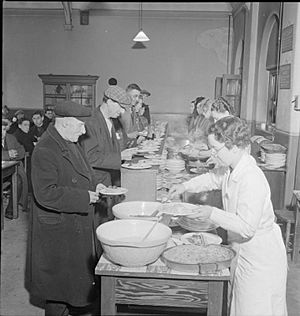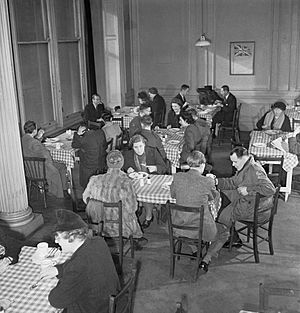British Restaurant facts for kids

British Restaurants were special places to eat that opened in 1940 during World War II. They were like community kitchens. These restaurants helped people who had lost their homes from bombings. They also helped those who ran out of food coupons or needed an affordable meal.
By 1943, there were 2,160 British Restaurants across the country. They served about 600,000 very cheap meals every day. These restaurants closed down in 1947. Some people hoped they would stay open forever. They wanted to make sure everyone, rich or poor, could always get healthy food.
Contents
Why British Restaurants Started
The idea for these restaurants came about during World War II. At first, they were called "Community Feeding Centres." But Prime Minister Winston Churchill chose the name "British Restaurants."
The Ministry of Food set them up. Local councils or volunteer groups ran them. They were not meant to make a profit. Meals were very cheap, costing 9 old pence or less. This was about the same as £1 in today's money.
Food Rules
There were rules about what you could eat. You could only have one serving of meat, fish, eggs, or cheese. Some restaurants prepared meals at a central kitchen. Then they delivered the food to the restaurants.
Schools and churches were often used as locations. They already had dining halls and kitchens. In London, mobile canteens delivered meals. They brought food to air raid shelters and people on the street after bombings.
Private Restaurants
Regular private restaurants still operated during the war. They were not part of the British Restaurant system. However, they also had some rules. For example, a meal could not have more than three courses. The most expensive meal could only cost five shillings.
By mid-1941, over 200 British Restaurants were open in London. They were very popular there. By November 1942, there were 1,899 restaurants nationwide. By 1943, this number grew to 2,160. Most of them made a small profit, but some lost money. They were designed to be non-profit.
Some smaller towns did not have their own British Restaurant. Instead, they had "Cash and Carry Restaurants." These places got their meals delivered from a nearby British Restaurant.
What Food Was Served?
The Ministry's food expert, James H. Barker, approved the meals. He made sure the food was healthy and suited local tastes. For example, food in Scotland was different from food in London. This was because people in different areas liked different things.
Healthy Meals
Health was a big concern. The meals were supposed to give people "one third of the day's energy needs." Experts were especially worried about people getting enough Vitamin C. During the war, it was hard to get fresh fruit. So, vegetables like cabbage, which has a lot of Vitamin C, were a common food. They wanted to make sure people got important nutrients.
People said the food at British Restaurants was filling and good quality. For just 9 pence, customers could get a three-course meal. People usually wanted a meal with meat and two vegetables. There were often choices of five meat dishes, five vegetables, and five desserts. In bigger cities, there were even more options.
Popular dishes included roasts and potatoes. Potatoes were often used instead of bread. The food could be made in large amounts. This made it easy to feed many people. Food preparation was like a factory. Volunteers used machines to slice potatoes, not just their hands. This helped keep costs low.
After the War
After 1947, many British Restaurants closed. Some were changed into "civic restaurants." These were run by local councils under a new law. In 1949, 678 of these restaurants still existed.
Even after the war, food was still rationed. The Labour government wanted to make society fairer. The Minister of Food, John Strachey, said that private restaurants mostly served richer people. He felt that working-class people needed more options.
If a civic restaurant lost money for three years in a row, it needed special permission to stay open. Some of these restaurants lasted until the late 1960s. Cambridge had one until the early 1970s.
See also


